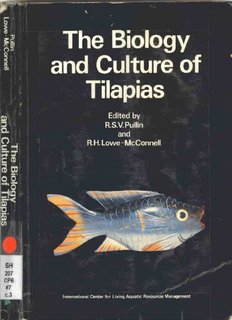Introduction
Tilapias are a major protein source in many of the developing countries. Although endemic to Africa, their distribution has been widened by artificial introductions, mainly since the 19508, to include much of the tropics and subtropics.
Tilapias have many attributes that recommend them for culture. They show excellent growth rates on low protein diets, whether cropping natural aquatic production or receiving supplementary food.
They tolerate wide ranges of environmental conditions, show little susceptibility to disease and are amenable to handling and captivity. They have a short generation time and breed in captivity.
Most important of all, they enjoy wide acceptance as food fish because of their high palatability and history of use from inland fisheries. With all these advantages, tilapias could become prime domesticated species for fish culture.
The culture of tilapias, however, is still beset with problems of rearing and general husbandry. These result from an inadequate research base on their biology, particularly behavior and physiology, and insufficient cooperation between fish biologists and culturists.
The former has often pursued limited, essentially academic studies within their specialist fields and the latter have paid inadequate attention to published information. In particular, there is a great deal of information gathered by field biologists which is relevant to the behavior, growth and reproduction of tilapias in culture systems.
This conference was convened to bring biologists and culturists together to present reviews of existing information in their specialist fields; to discuss current research areas and culture methods; to define future research requirements and to comment on any other measures which would help the future development of tilapia culture.
It was seen as a unique opportunity to address some of the unresolved problems for researchers and culturists alike ranging from standardization of nomenclature and techniques for the development of known genetic strains and hybrids to optimization of growth and feeding and control of reproduction.
When editing this volume, we decided to accept the division of the tilapias into the genera Sarotherodon (mouthbrooders) and TYlapia (substrate spawners).
However, as explained in the addendum to Dr. Trewavas’ paper, the subgenus Oreochromis has been raised to generic status. The maternal mouthbrooding tilapias so far used in fish culture should now be referred to as Oreochromis (e.g., Oreochrornis mossam bicus, 0. niloticus, 0. aureus).
The generic name Sarotherodon is now restricted to a West African group (which includes S. melanotheron) and to S. galilaeus. ICLARM wishes to thank the Rockefeller Foundation, not only for providing the superb facilities of the Bellagio Study and Conference Center, but also for their generous sponsorship of the conference participants.
The administrator and staff of the Bellagio Center also deserve special thanks for their hard work and help in ensuring the success of this conference.
Finally, we wish to thank Dr. Roy Harden Jones for preparing the excellent indexes and Linda Temprosa for assembling the reference list.









Be the first to review “The Biology And Culture Of Tilapias”